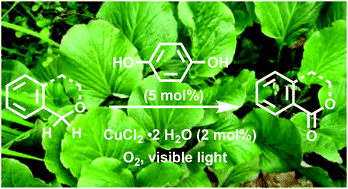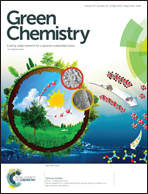Visible light mediated oxidation of benzylic sp3 C–H bonds using catalytic 1,4-hydroquinone, or its biorenewable glucoside, arbutin, as a pre-oxidant†
Abstract
Benzylic ethers undergo a visible light induced C–H activation and oxygen insertion to give the corresponding benzoate esters in moderate to good yields. The conditions employ substoichiometric amounts of 1,4-hydroquinone with copper(II) chloride dihydrate as an electron-transfer mediator, oxygen as the terminal oxidant and dimethyl carbonate as solvent under visible light irradiation. The naturally occurring glucoside, arbutin, which is commercially available or can be accessed via extraction of the leaves of bearberry (Arctostaphylos uva-ursi) or elephant ears (Bergenia crassifolia) can be used as a biorenewable source of 1,4-hydroquinone. The methodology exploits the increase in oxidizing ability of quinones upon irradiation with visible light, and offers a sustainable alternative for the late stage oxidative functionalization of benzylic C–H bonds. It is applicable to a range of cyclic benzylic ethers such as isochromans and phthalans, and simple benzyl alkyl ethers. It can also be applied in the oxidation of benzylic amines into amides, and of diarylmethanes into the corresponding ketones. Mechanistic studies suggest that the reaction proceeds by H-abstraction by the photo-excited triplet benzoquinone to give a benzylic radical that subsequently reacts with molecular oxygen.



 Please wait while we load your content...
Please wait while we load your content...